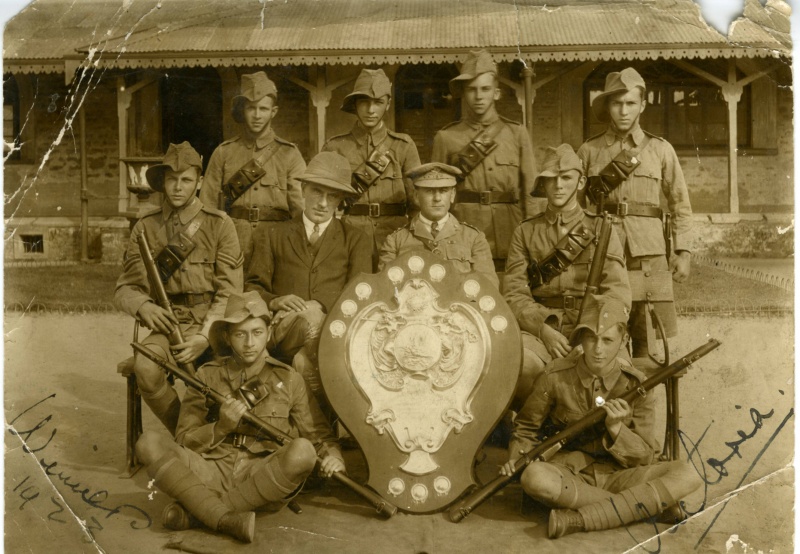File:1923 Group.jpg

Identification
'Frogsmile' has advised:[1]
The photo ...is wonderful and with the original print and a magnifying glass I am sure you could read the (almost certainly 'shooting') trophy at front centre of the group.
Although I have not ruled out completely Australia, or even New Zealand, I think it was most likely taken in South Africa. I am fairly sure it is not India.
The group are likely to be from a Colonial/Dominion Militia, or Volunteer unit following British practices. The rifles are .303 short, magazine (fed) Lee Enfields (i.e. SMLE) of WW1 fame. The uniforms are British style khaki drill (KD) with squared off pockets and pointed cuffs, a well known pattern of post WW1 vintage.
There are two unusual features. First are the hats, they are not the usual fur or wool felt, but are instead cotton drill or canvas and that is what gives them the floppy appearance. If you look you can see the rows of concentric stitching that attempt to give a stiffening effect. This later became common in jungle and desert wear but with a smaller brim. I have never seen Regulars wearing the type of 'slouch' (aka 'Terai') hat shown. Second are the bandoliers that appear to be a locally made variant after the style of 1903 mounted infantry bandolier equipment and 1901 naval bandolier equipment. They have the narrow shoulder straps of the latter and the 'squared off' (rather than the usual tapered) ammunition pouches of the MkII, 15-round capacity type of the former. Looking at the way the weight drags the pouches down I would say that each pouch (x4) has 3, 5-round clips on chargers (metal guides) and most unusually, between each pair of pouches is a flap covering 5 independent rounds, each enclosed in a loop. I have never seens this type before but South Africa was renowned for using variations of the 1903 bandolier right up until WW2.
The soldiers themselves do not have the seasoned appearance of British Regulars and appear too youthful, especially the NCOs. Looking at the two lads seated cross legged, they have a Jewish/Central European appearance (especially at left) and this might relate to the name inscribed front left on the photo. There was a significant Jewish community in South Africa at that time, who were drawn to the Diamond Fields and it seems possible that there is a connection.
Unfortunately I cannot make out the cap badge of the officer, as it is partially obscured by his cap, but it is interesting that he has a trench type cap (with an ear warmer curtain) and is also dressed in KD service dress. His badge is reminiscent of several British infantry regiments, but as the star shape was so common, it could just as easily be a militia/volunteer unit and I believe that to be more likely given the points brought out in the rest of the image. He has a medal ribbon but it is not something I recognise. If you post a close up of just the ribbon one of the forum experts on medals might well be able to make an ID.
At the rear of the group is a typical guard house with double door entrance and verandah. This style was used throughout the Empire and even at home so that in inclement weather, the guard could be formed up and inspected by the duty picquet officer, under cover.
References
Licensing
|
This work is licensed under the Creative Commons Attribution 3.0 unported License. Specific Attribution: Owned by Hilary Sheridan Anyone may use this image for any purpose provided it is attributed as specified. |
File history
Click on a date/time to view the file as it appeared at that time.
| Date/Time | Thumbnail | Dimensions | User | Comment | |
|---|---|---|---|---|---|
| current | 08:23, 4 April 2012 |  | 3,738 × 2,589 (702 KB) | Lee (talk | contribs) |
- You cannot overwrite this file.
File usage
There are no pages that use this file.
